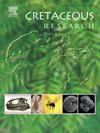Taphonomic patterns in lower cretaceous fish assemblages: Evidence from the Sergipe-Alagoas Basin, Brazil
IF 1.7
3区 地球科学
Q1 GEOLOGY
引用次数: 0
Abstract
Taphonomic processes affecting vertebrate remains vary across environments, resulting in preservation patterns typical of different physical settings. Fish taphonomy, in particular, provides valuable insights into limnology, community composition, life history, mortality, depositional conditions, and preservation mechanisms. However, most taphonomic studies on fossil fish have focused on lacustrine deposits, leaving marine deposits comparatively underexplored. Research on marine settings often emphasizes mortality causes, such as abrupt temperature changes, cold shocks, hypothermia, and low dissolved oxygen levels. The paleoichthyofauna of the Morro do Chaves Formation (MCF) is generally regarded as diverse, abundant, and well-preserved. Despite this, most previous studies have emphasized taxonomy and systematics, with limited focus on paleoecological and taphonomic aspects. This study addresses this gap through a comprehensive taphonomic analysis of the MCF fish assemblage, integrating the latest paleobiological, sedimentological and stratigraphic data. Qualitative and quantitative analyzes from 133 specimens revealed four distinct taphofacies distributed throughout the formation. The MCF represents a seasonal lacustrine paleoenvironment, as indicated by cyclic deposits of coquinas, shales, and sandstones, along with sedimentary structures such as mud cracks. Two distinct paleoenvironmental interpretations emerge for the MCF: the Sergipe portion represents the paleolake border, while the Alagoas portion corresponds to the more distal portion of the paleolake. The occurrence of fish remains spanning various ontogenetic stages, along with bioclasts aligned parallel to bedding planes, indicates minimal reworking, short transport distances, and non-selective mortality events. Furthermore, the presence of marine taxa in MCF indicates sporadic yet intense marine incursions in the northern Sergipe-Alagoas Basin during the Early Cretaceous.
下白垩纪鱼类组合的地理模式:来自巴西Sergipe-Alagoas盆地的证据
影响脊椎动物遗骸的埋藏过程因环境而异,导致不同物理环境的典型保存模式。特别是鱼类地层学,对湖沼学、群落组成、生活史、死亡率、沉积条件和保存机制提供了有价值的见解。然而,大多数鱼类化石的地貌学研究都集中在湖泊沉积物上,而海洋沉积物的勘探相对较少。对海洋环境的研究往往强调死亡原因,如温度突然变化、冷休克、体温过低和溶解氧水平低。Morro do Chaves组(MCF)的古鱼区系通常被认为是多样、丰富且保存完好的。尽管如此,以往的研究大多侧重于分类学和系统学,对古生态和地层学方面的关注有限。本研究通过综合最新的古生物学、沉积学和地层学资料,对MCF鱼类组合进行全面的地层学分析,解决了这一空白。通过对133个样品的定性和定量分析,揭示了四种不同的触相分布在整个地层中。MCF代表了一个季节性的湖相古环境,其特征是coquinas、页岩和砂岩的循环沉积,以及泥裂缝等沉积构造。MCF出现了两种不同的古环境解释:Sergipe部分代表古湖泊边界,而Alagoas部分对应古湖泊的更远部分。鱼类遗骸的出现跨越了不同的个体发育阶段,生物碎屑平行于层理平面排列,表明了最小的改造,短的运输距离和非选择性死亡事件。此外,MCF中海洋分类群的存在表明早白垩世早期Sergipe-Alagoas盆地北部有零星但强烈的海洋入侵。
本文章由计算机程序翻译,如有差异,请以英文原文为准。
求助全文
约1分钟内获得全文
求助全文
来源期刊

Cretaceous Research
地学-地质学
CiteScore
4.10
自引率
19.00%
发文量
235
审稿时长
12 weeks
期刊介绍:
Cretaceous Research provides a forum for the rapid publication of research on all aspects of the Cretaceous Period, including its boundaries with the Jurassic and Palaeogene. Authoritative papers reporting detailed investigations of Cretaceous stratigraphy and palaeontology, studies of regional geology, and reviews of recently published books are complemented by short communications of significant new findings.
Papers submitted to Cretaceous Research should place the research in a broad context, with emphasis placed towards our better understanding of the Cretaceous, that are therefore of interest to the diverse, international readership of the journal. Full length papers that focus solely on a local theme or area will not be accepted for publication; authors of short communications are encouraged to discuss how their findings are of relevance to the Cretaceous on a broad scale.
Research Areas include:
• Regional geology
• Stratigraphy and palaeontology
• Palaeobiology
• Palaeobiogeography
• Palaeoceanography
• Palaeoclimatology
• Evolutionary Palaeoecology
• Geochronology
• Global events.
 求助内容:
求助内容: 应助结果提醒方式:
应助结果提醒方式:


